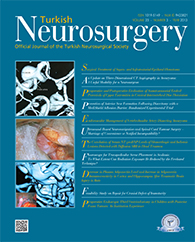2Antalya Education and Research Hospital, Department of Orthopaedics and Traumatology, Antalya, Turkey
3Yenimahalle State Hospital, Department of Neurosurgery, Ankara, Turkey DOI : 10.5137/1019-5149.JTN.7016-12.1 AIM: In spinal surgery, high doses of radiation are delivered during surgical procedures that require fluoroscopic control. The aim of this study was to determine the amount of radiation delivered from the fluoroscopic unit and also the factors to reduce the amount of radiation during the surgery of adolescent idiopathic scoliosis patients.
MATERIAL and METHODS: In this retrospective study 21 patients with adolescent idiopathic scoliosis treated by transpedicular screws between 2009 and 2012 were enrolled the study. Dose Area Product (DAP) values , number of views obtained during screw placement and other data were retrieved from the medical records of the patients.
RESULTS: The mean number of transpedicular screws used was 18. An average of 10,1 vertebrae were instrumented. The mean number of images obtained was 7.76. Mean fluoroscopy time was 7.95 seconds. The total mean DAP was 64.6 cGy.cm2.
CONCLUSION: The amount of ionizing radiation transmitted to the patient and the surgical team can be reduced by freehand insertion, confirmation of screw position by AP and lateral fluoroscopic views including more than one segment, the use of K-wires as a guide in spinal segments with abnormal pedicular anatomy and neuromonitorization of the patient during the surgical correction of adolescent idiopathic scoliosis.
Keywords : Scolisosis, Fluoroscopy, Radiation dosage, Instrumentation




